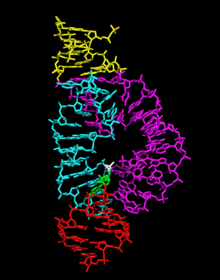Virusoid
Virusoids are circular single-stranded RNA(s) dependent on viruses for replication and encapsidation.[1] The genome of virusoids consist of several hundred (200–400) nucleotides and does not code for any proteins.
Virusoids are essentially viroids that have been encapsulated by a helper virus coat protein. They are thus similar to viroids in their means of replication (rolling circle replication) and in their lack of genes, but they differ in that viroids do not possess a protein coat. Both virusoids and viroids encode a hammerhead ribozyme.
Virusoids, while being studied in virology, are subviral particles rather than viruses. Since they depend on helper viruses, they are classified as satellites. Virusoids are listed in virological taxonomy as Satellites/Satellite nucleic acids/Subgroup 3: Circular satellite RNA(s).[2]
Depending on whether a lax or strict definition is used, the term virusoid may also include Hepatitis D virus (HDV). Like plant virusoids, HDV is circular, single-stranded, and supported by a helper virus (Hepatitis B virus) to form virions; however, the virions possess a much larger genome size (~1700 nt) and encode a protein.[3][4] They also show no sequence similarity with the plant virusoid group.
The first virusoid was discovered in Nicotiana velutina plants infected with Velvet tobacco mottle virus R2 (VTMOV).[5][6] These RNAs have also been referred to as viroid-like RNAs that can infect commercially important agricultural crops and are non–self-replicating single stranded RNAs.[7] RNA replication of virusoids is similar to that of viroids but, unlike viroids, virusoids require specific "helper" viruses.
The circular structure of virusoid RNA molecules is ideal for rolling circle replication, in which multiple copies of the genome are generated in an efficient manner from a single replication initiation event.[8] Another advantage to circular RNAs as replication intermediates is that they are inaccessible and resistant to exonucleases. Additionally, their high GC content and high degree of self-complementarity make them very stable against endonucleases. Circular RNAs impose constraints on RNA folding by which secondary structures that are favored for replication differ from those assumed during ribozyme-mediated self-cleavage.

